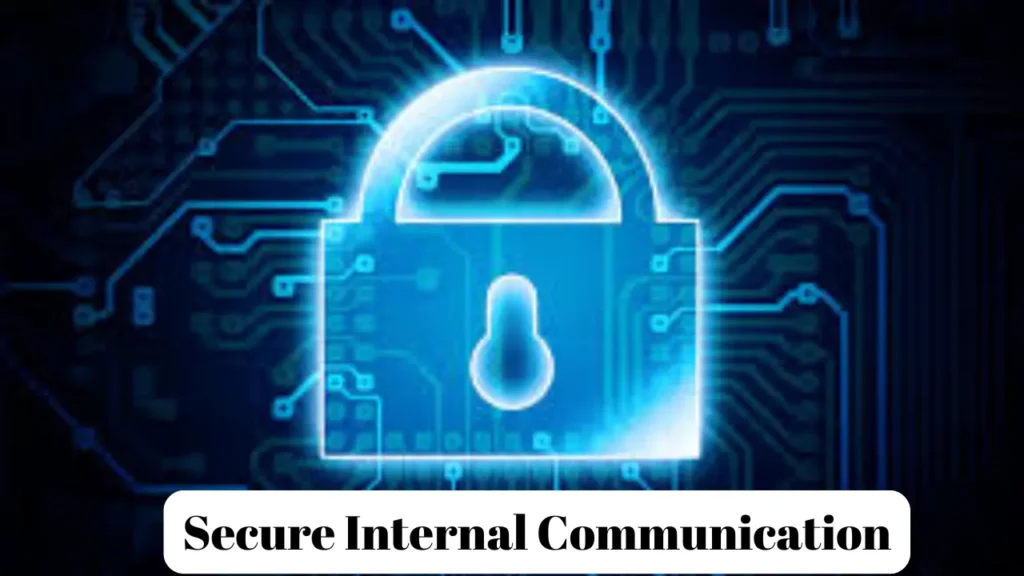Secure Internal Communication: Identifying Risks and Implementing Effective Solutions
Secure internal communication is essential for safeguarding sensitive company data, meeting regulatory requirements, and maintaining operational integrity. It prevents financial and reputational harm while building confidence within a business. Safeguarding internal communication helps firms avoid exposing confidential data and comply with requirements like GDPR and HIPAA.
Effective security measures prevent cyber risks, ensure business continuity, and improve corporate governance. Robust internal communication protection promotes stakeholder trust, prevents operational disruptions, and safeguards the company’s reputation.
Why Secure Internal Communication is Essential
Secure internal communication, particularly within companies, is vital. Its primary purpose is to protect sensitive information such as financial data, strategic plans, intellectual property, and personal personnel details. These are frequently targeted by cybercriminals and can result in severe financial and reputational damage if compromised.
Furthermore, secure internal communication is critical for ensuring compliance with standards such as GDPR, HIPAA, and SOX, which require stringent data security protocols. Failure to safeguard communication connections might lead to serious legal consequences. More significantly, it protects against phishing, social engineering, malware, and ransomware assaults, which can impair business operations.
Securing internal communication and fostering trust among employees, partners, and customers ensures operational integrity and company continuity. Another benefit is protection against insider threats, which can prevent fraud and data leaks.
A positive public image is essential for company success, and security breaches can have disastrous consequences for an organization’s brand. IBM’s 2023 research found that the global average cost of a data breach was $4.45 million, emphasizing the financial risks involved.
To ensure internal communication security, businesses must identify common threats and apply suitable solutions.
Common Risks Threatening Secure Internal Communication
Secure internal communication within organizations is vital for protecting sensitive information and maintaining business continuity. However, several risks can threaten the security of this communication, including:
1. Phishing Attacks
- Description: Phishing involves malicious actors impersonating legitimate individuals or services to deceive employees into revealing sensitive information.
- Impact: Successful phishing can lead to unauthorized access to internal communication channels, data breaches, and compromised employee credentials.
2. Insider Threats
- Description: Employees or contractors with access to sensitive information can intentionally or accidentally leak information.
- Impact: Insider threats can be more damaging than external attacks because they involve trusted individuals with access to sensitive systems.
3. Weak Authentication Protocols
- Description: Inadequate or outdated authentication mechanisms, such as weak passwords or lack of multi-factor authentication (MFA), can expose internal communication channels.
- Impact: Attackers can exploit weak authentication to gain unauthorized access to systems, posing a significant security risk.
4. Unencrypted Communication
- Description: Communication that is not encrypted can be intercepted by cybercriminals during transmission.
- Impact: Unencrypted internal communications can lead to data theft or manipulation, exposing sensitive business information to unauthorized parties.
5. Misconfigured Access Controls
- Description: Improperly configured access permissions can allow unauthorized individuals to access restricted communication channels.
- Impact: Misconfigurations can lead to data breaches and leaks of sensitive company information.
6. Shadow IT
- Description: Employees using unauthorized tools or services to communicate or share information can create vulnerabilities in the organization’s security infrastructure.
- Impact: Shadow IT can bypass internal security measures, exposing communication to risks that the IT department is unaware of.
7. Outdated Software and Systems
- Description: Using outdated software or communication systems increases the risk of vulnerabilities that can be exploited by hackers.
- Impact: Unpatched systems can be an entry point for attackers to intercept or manipulate internal communications.
8. Malware and Ransomware
- Description: Malware can infiltrate communication systems, allowing attackers to monitor or steal sensitive data.
- Impact: Ransomware can lock employees out of communication systems, disrupting business operations and leading to potential data loss.
9. Insecure Mobile Devices
- Description: Employees accessing internal communication on unsecured or unmanaged mobile devices pose a risk to the organization’s security.
- Impact: Mobile devices without proper security controls can be vulnerable to hacking or data leakage.
10. Social Engineering
- Description: Attackers may use psychological manipulation to trick employees into disclosing sensitive communication details.
- Impact: Social engineering can lead to unauthorized access to communication systems or compromise the integrity of confidential discussions.
11. Third-Party Service Providers
- Description: Using external vendors or third-party services for internal communication without proper vetting can introduce vulnerabilities.
- Impact: If third-party providers are compromised, it can lead to breaches in the organization’s internal communications.
12. Lack of Employee Training
- Description: Employees who are not trained on secure communication practices may unintentionally expose sensitive information.
- Impact: A lack of awareness can result in falling victim to attacks, such as phishing or social engineering.
Solutions for Securing Internal Communication
Securing internal communication is essential to protect sensitive business information and maintain operational integrity. Below are key solutions that can help enhance the security of internal communication systems:
1. End-to-End Encryption
- Description: Ensure that all internal communication, including emails, messaging apps, and voice calls, is encrypted from sender to receiver.
- Solution: Use tools that offer end-to-end encryption, such as Signal, WhatsApp for Business, or encrypted email services. This ensures that even if communication is intercepted, it cannot be read by unauthorized parties.
2. Multi-Factor Authentication (MFA)
- Description: Strengthen user authentication by requiring multiple forms of verification (e.g., passwords, biometrics, one-time codes).
- Solution: Implement MFA across all communication platforms to prevent unauthorized access, even if credentials are compromised.
3. Zero Trust Security Model
- Description: Assume that no one, whether inside or outside the organization, should be trusted by default. Each access request should be verified continuously.
- Solution: Adopt a zero-trust framework for internal communication, applying strict identity verification, segmentation of network access, and least-privilege access controls to protect sensitive information.
4. Secure Communication Tools
- Description: Use dedicated, secure communication platforms designed for enterprise use, offering robust security features.
- Solution: Tools like Microsoft Teams, Slack Enterprise Grid, or Cisco Webex, equipped with enterprise-grade security controls, can help ensure secure and compliant internal communication.
5. Data Loss Prevention (DLP) Solutions
- Description: Monitor and control the movement of sensitive data within communication systems to prevent leaks or breaches.
- Solution: Implement DLP software that detects and prevents unauthorized data transfers in real time, ensuring sensitive data is not shared outside the organization.
6. Role-Based Access Control (RBAC)
- Description: Restrict access to communication channels and information based on employee roles and responsibilities.
- Solution: Configure RBAC to ensure only authorized employees can access certain communication threads or files. For example, sensitive projects may only be accessible to senior-level management.
7. Regular Security Audits
- Description: Periodically review the security measures in place for internal communication systems.
- Solution: Conduct regular audits to identify vulnerabilities in communication platforms, permissions, and protocols, and implement updates based on findings.
8. Mobile Device Management (MDM)
- Description: Ensure that employees accessing internal communication systems from mobile devices do so securely.
- Solution: Implement MDM solutions like Microsoft Intune or VMware AirWatch to control, monitor, and secure corporate communications on employee devices, ensuring compliance with security policies.
9. Secure VPNs and Remote Access
- Description: Use virtual private networks (VPNs) to ensure secure remote access to communication platforms.
- Solution: Enforce the use of corporate VPNs for employees working remotely to ensure all communication traffic is encrypted and protected from external threats.
10. Endpoint Security
- Description: Protect the devices employees use for communication, such as laptops and smartphones, from malware and hacking attempts.
- Solution: Use antivirus software, firewalls, and intrusion detection/prevention systems (IDS/IPS) to secure endpoints and prevent them from being compromised.
Best Practices for Protecting Sensitive Data
To fully secure internal communication, organizations should also implement best practices for data protection:
- Encrypt data during both transmission and storage.
- Use MFA and RBAC to control access.
- Employees receive regular training on security protocols.
- Use DLP tools and secure platforms.
- Conduct regular security audits and incident response drills.
Intranet Security: On-Premises or Cloud?
Both on-premises and cloud-based intranets provide secure solutions when managed correctly. On-premises intranets give you complete control over security, but they need significant maintenance resources. Cloud-based intranets benefit from increased security provided by cloud service providers, but they must be properly built and managed to be secure.
Choosing a Secure Internal Communication Platform
It is critical to choose a communication platform that adheres to high security standards. Search for platforms with ISO 27001 and SOC 2 Type 2 certifications. Platforms such as Staffbase offer extensive security, including encryption, frequent audits, and a dedicated security team.
Following these standards and best practices can help firms develop a secure communication environment, protecting internal communications against breaches and leaks.
For more information, please visit our homepage




This definately clears about internal communication please give blog about what kind of internal communication used by our banking system internationally and nationally.
Sure. I will write a detailed blog on it.
The Pakistani banking system relies on emails, secure messaging platforms, and intranet portals for internal communication nationally. Video conferencing tools like Zoom and Microsoft Teams are used for real-time communication across branches. Internationally, banks adopt encrypted messaging systems and global collaboration platforms for seamless cross-border coordination and compliance updates.